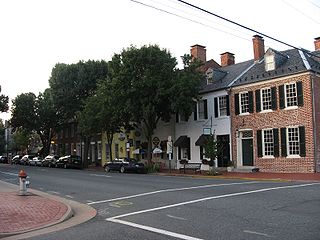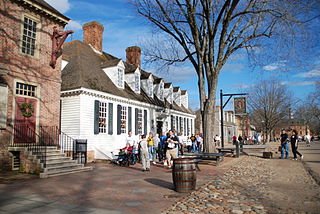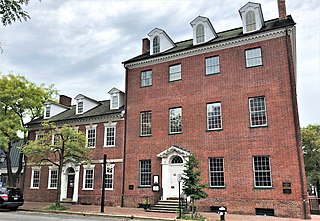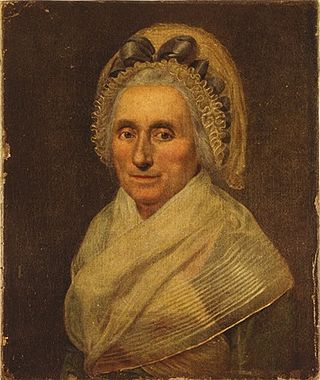
Fredericksburg is an independent city in Virginia, United States. As of the 2020 census, the population was 27,982. It is 48 miles (77 km) south of Washington, D.C., and 53 miles (85 km) north of Richmond. The Bureau of Economic Analysis of the United States Department of Commerce combines the city of Fredericksburg with neighboring Spotsylvania County for statistical purposes.

Colonial Williamsburg is a living-history museum and private foundation presenting a part of the historic district in the city of Williamsburg, Virginia. Its 301-acre (122 ha) historic area includes several hundred restored or recreated buildings from the 18th century, when the city was the capital of the Colony of Virginia; 17th-century, 19th-century, and Colonial Revival structures; and more recent reconstructions. The historic area includes three main thoroughfares and their connecting side streets that attempt to suggest the atmosphere and the circumstances of 18th-century Americans. Costumed employees work and dress as people did in the era, sometimes using colonial grammar and diction.

Founded in 1889, the Association for the Preservation of Virginia Antiquities was the United States' first statewide historic preservation group. In 2003 the organization adopted the new name APVA Preservation Virginia to reflect a broader focus on statewide Preservation and in 2009 it shortened its name to Preservation Virginia. Preservation Virginia owns historic sites across Virginia including Historic Jamestowne, located at Jamestown, Virginia, site of the first permanent English settlement in North America, and the Cape Henry Light house, one of the first public works projects of the United States of America.

Chatham Manor is a Georgian-style mansion home completed in 1771 by farmer and statesman William Fitzhugh, after about three years of construction, on the Rappahannock River in Stafford County, Virginia, opposite Fredericksburg. It was for more than a century the center of a large, thriving plantation and the only private residence in the United States to be visited by George Washington, Thomas Jefferson, Abraham Lincoln, and Dwight D. Eisenhower.

Ferry Farm, also known as the George Washington Boyhood Home Site or the Ferry Farm Site, is the farm and home where George Washington spent much of his childhood. The site is located in Stafford County, Virginia, along the northern bank of the Rappahannock River, across from the city of Fredericksburg. In July 2008, archaeologists announced that they had found remains of the boyhood home, which had suffered a fire during 1740, including artifacts such as pieces of a cream-colored tea set probably belonging to George's mother, Mary Ball Washington. In 2015, the George Washington Foundation began constructing a replica of Washington's boyhood home on the site of the original building. The replica house was completed in 2018 and is open to the public.

The Poe Museum or the Edgar Allan Poe Museum, is a museum located in the Shockoe Bottom neighborhood of Richmond, Virginia, United States, dedicated to American writer Edgar Allan Poe. Though Poe never lived in the building, it serves to commemorate his time living in Richmond. The museum holds one of the world's largest collections of original manuscripts, letters, first editions, memorabilia and personal belongings. The museum also provides an overview of early 19th century Richmond, where Poe lived and worked. The museum features the life and career of Poe by documenting his accomplishments with pictures, relics, and verse, and focusing on his many years in Richmond.

Charles Washington was an American planter and politician who founded a town in the Shenandoah Valley that was named Charles Town in his honor shortly after his death and that of his eldest brother, George Washington.

Fielding Lewis was an American merchant, member of the House of Burgesses and a Colonel during the American Revolutionary War. He lived in Fredericksburg, Virginia and also owned a plantation in Spotsylvania County, which later became known as Kenmore. His brother-in-law was George Washington, who was also his 2nd cousin, he was also 2nd cousins with Betty Washington.

Gadsby's Tavern is a complex of historic buildings at 134 and 138 North Royal Street at the corner of Cameron Street in the Old Town district of Alexandria, Virginia. The complex includes a c.1785 tavern, the 1792 City Tavern and Hotel, and an 1878 hotel addition. The taverns were a central part of the social, economic, political, and educational life of the city of Alexandria at the time. Currently, the complex is home to Gadsby's Tavern Restaurant, American Legion Post 24, and Gadsby's Tavern Museum, a cultural history museum. The museum houses exhibits of early American life in Virginia, and the restaurant operates in the original 1792 City Tavern dining room, serving a mixture of period and modern foods.

Mary Washington was an American planter best known for being the mother of the first president of the United States, George Washington. The second wife of Augustine Washington, she became a prominent member of the Washington family. She spent a large part of her life in Fredericksburg, Virginia, where several monuments were erected in her honor and a university, along with other public buildings, bear her name.

Historic Jamestown is the cultural heritage site that was the location of the 1607 James Fort and the later 17th-century town of Jamestown in America. It is located on Jamestown Island, on the James River at Jamestown, Virginia and operated as a partnership between Preservation Virginia and the U.S. National Park Service as part of Colonial National Historical Park.

St. George's Episcopal Church is a church in Fredericksburg, Virginia at 905 Princess Anne Street. The church, built in the 18th century and re-built in 1815 and 1849, is a part of the Episcopal Diocese of Virginia. The building was listed on the National Register of Historic Places in 2019.

Kenmore, also known as Kenmore Plantation, is a plantation house at 1201 Washington Avenue in Fredericksburg, Virginia. Built in the 1770s, it was the home of Fielding and Elizabeth Washington Lewis and is the only surviving structure from the 1,300-acre (530 ha) Kenmore plantation.

The Lee–Fendall House is a historic house museum and garden located in Old Town Alexandria, Virginia, United States, at 614 Oronoco Street. Since its construction in 1785, the house has served as home to thirty-seven members of the Lee family (1785–1903), hundreds of convalescing Union soldiers (1863–1865), the prominent Downham family (1903–1937), the family of powerful labor leader John L. Lewis (1937–1969), and enslaved or free servants of those families.

Hugh Mercer Apothecary was an apothecary founded by Hugh Mercer in the mid-18th century. Mercer was a doctor who fled Scotland after the Battle of Culloden. He travelled to Pennsylvania, where he met Colonel George Washington during the French and Indian War and later moved to Fredericksburg, Virginia, on Washington's advice to practice medicine and operate an apothecary.

The John Marshall House is a historic house museum and National Historic Landmark at 818 East Marshall Street in Richmond, Virginia. It was the home of Chief Justice of the United States and Founding Father John Marshall, who was appointed to the court in 1801 by President John Adams and served for the rest of his life, writing such influential decisions as Marbury v. Madison (1803) and McCulloch v. Maryland (1819).

The Old Stone House is one of the oldest structures in Washington, D.C. The house is also the last pre-revolutionary colonial building in Washington, D.C. Built in 1765, Old Stone House is located at 3051 M Street, Northwest in the city's Georgetown neighborhood. Sentimental local folklore preserved the Old Stone House from being demolished, unlike many colonial homes in the area that were replaced by redevelopment.

The Rising Sun Tavern is a historic building in Fredericksburg, Virginia. It was built in about 1760 as a home by Charles Washington, youngest brother of George Washington, and became a tavern in 1792.

Rodgers Tavern, also known as Stevenson's Tavern, is a historic hotel located at Perryville, Cecil County, Maryland, United States. It is a mid-18th-century, two-story stone structure with a basement. All rooms have corner fireplaces. It was frequently visited by George Washington between the years 1755 and 1798, when it was owned and operated as an inn and tavern by Colonel John Rodgers (1728–1791). He was the father of John Rodgers (1772–1838), U.S. naval officer. During the 1880s the house was divided into two halves, east and west.
Christiana Burdett Campbell was a colonial innkeeper from Williamsburg, Virginia. She started the business herself in an era where it was unusual for women to do so in the colony. A replica of her tavern was built in Colonial Williamsburg and currently serves as a popular tourist attraction and restaurant.

























